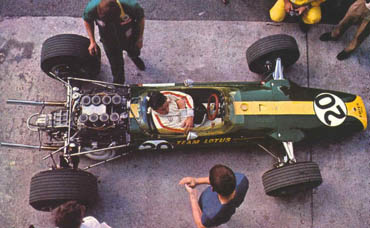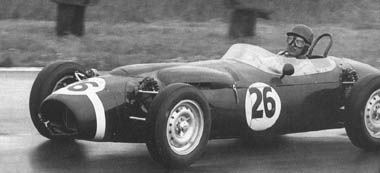 |
|
| The F1 FAQ | |
| by Mark Alan Jones, Australia; images provided by Rainer Nyberg | |
|
Have a question about Formula One statistics or history? Well you're not the only one, and it's about time someone came up with the answers to Formula One's most Frequently Asked Questions. Send us your questions, to faq@atlasf1.com - we may not know everything, but we will sure make the effort to find out
Jordan's 1998 season could have made for an excellent book. In fact it did, as my colleague Mark Glendenning reviewed in last week's Atlas F1. Jordan didn't score a point in last year's season until the ninth round at Silverstone, where in abysmally bad weather Ralf Schumacher managed to salvage a sixth and one championship point for the team. Schumacher followed it up with a fifth at the A-1Ring, then a pair of fourths for Damon Hill at the horsepower haven of Hockenheim and the tortuous Hungaroring. The following race was the greatest moment in the history of Jordan Grand Prix.
In 1999 Heinz-Harald Frentzen was second at Albert Park and third at Interlagos. Hill finished neither races. Jordan's website can be found at http://www.jordangp.com for a more detailed look at Formula One results head to http://www.forix.com and this years calendar can be found at http://atlasf1.autosport.com/news/1999calendar.htm.
"When was the last time a full compliment of teams were entered in a race? By this I mean that the rules for Formula One stipulate that only a certain number of cars may run. For at least the last couple of years the number of cars has been below this mandatory limit. Has there ever been a time when there were more cars than qualifying spaces, as in NASCAR? Lately, when the officials of Formula One have spoken about adding a race to the circuit, it is usually at the expense of an already established venue. When was the last time Formula One ran the full potential compliment of races, if ever? Frederick H." The grid density for a Formula One race was set at its current level of 26 cars back in 1982, prior to that it was 24. Although exception was made at Monaco where it was acknowledged that the circuit couldn't handle more than 20 cars, a decision which was changed to the full 26 in 1987. Prior to 1978, the grid density was set locally and varied from circuit to circuit. This year and last year there was only 12 teams so only 24 of the 26 spots were full. In 1997 there were only 22 cars (once Lola folded), 1996 only 20 (after Forti Corse folded). For the early part of the 1995 season there were 26 cars but the collapse of Simtek reduced that to 24. For 1994 there were 28 cars at each race ensuring on race-day two drivers (usually a combination of Simtek and Pacific drivers) watched from the pits or corporate boxes. In 1993 we were undersubscribed again with 24 cars. In 1992 there were 32 cars at times. 34 in 1991 and 35 in 1990. In 1989 there were a record 39 cars trying to make it into 26 grid spots at most races. From 1989 to 1992 when there was over 30 cars, a practice called pre-qualifying was used. 30 cars is the maximum allowed into a Friday or Saturday qualifying session so on the Thursday prior to each race all but 26 protected cars would venture out to compete for the four remaining spots in qualifying. 26 cars (usually the 13 teams who had scored the most points from the previous 16 Grands Prix) automatically pre-qualified. The automatic pre-qualifiers were re-evaluated every 8 races. As for a full compliment of races? There have been very few times where there has not been a full compliment of races, the number just varies. Since 1973 the number of Grands Prix each season has varied from 14 to 17 races. From 1967 to 1972 the number hovered between 11 and 13. Prior to that the fewest number of races was seven, in the first season in 1950, and again in 1955, but that was after four races were cancelled in the wake of the 1955 Le Mans disaster, where Pierre Levegh's Mercedes sports car rolled into the crowd, killing and injuring a huge number of people (the exact number was never released). In recent times the number of races was set at 16. The FIA however want to increase this number to 20 in the next few years and the teams have reluctantly agreed, but the FIA is finding it hard to find viable venues after the collapse of economies in the South East Asian region eliminated the prospect of races in Korea and Indonesia. The Chinese race was also put off a year, and Argentina and South Africa have also had more specific financial difficulties. China and the United States will be added next year, with no other races being eliminated to allow them in, making for an 18 race season.
"Can you tell me what car and drivers were run in the following: Ferrari - 1979 (I think it was the 312T3) and Renault - 1983 (I think it was the RE30B). Thank you for any help you can give me on this. Jeff" 1979 was of course a big year for Ferrari. The great South African Jody Scheckter and the revered Canadian Gilles Villeneuve won 6 races between them winning the constructors title in the 312T4 cars (the 312T3 was used at the first race only). Scheckter won the world championship, a feat no Ferrari driver has emulated since. Scheckter won at Zolder, Belgium, Monaco and Monza, Italy, collecting 51 points, and Villeneuve won at Kyalami, South Africa, Long Beach and Watkins Glen in the United States, collecting 47 points to finish runner-up to Scheckter.
In fact, going into the last round in Kyalami, South Africa, Piquet, Prost and Ferrari's Rene Arnoux all had a chance at the title. Mechanical failure put paid to Prost and Arnoux, and Piquet finished third to seal his second World Championship. Prost's team mate was the American Eddie Cheever who collected 22 points with his best result being a second at the Canadian Grand Prix at the Circuit Gilles Villeneuve.
To answer you're question directly Jordy, a guarded no. Starts are always a bit chaotic. With the new grooved tyre rules, the best time to make up for a poor grid spot now is at the start. At the start of each race 24 drivers stare at the red light and launch when the light goes out, then they take care of any slow starting cars in front of them. But once the race has run a couple of laps the 'accordion effect' does take place in accelerating away from each corner. Drivers following closely do have a danger of running up the back of the car in front if the stamp on the gas a little before the other car, such is the acceleration of the modern Formula One car.
The 1968 season was a slightly odd season for a number of reasons. The first race of the season was held at Kyalami in South Africa on New Years day. Jim Clark and Graham Hill destroyed the field in the glorious Cosworth DFV powered Lotus 49 that had showed so much promise late in 1967. Clark's race average speed was some 16 kph faster than Pedro Rodriguez had been in 1967 in the Cooper-Maserati. It would be the last World Championship Formula One race Clark would ever race. Round 2 wasn't scheduled until May 12. In between Kyalami and Jarama, Spain, a large contingent of the Grand Prix circus stayed south of the equator, and arrived in New Zealand for the opening round of the Tasman Cup of which Clark was the defending champion. At the New Zealand Grand Prix at Pukekohe, Clark in a 2.5 litre version of the Lotus 49 Cosworth DFV (Tasman Cup rules were for Formula One or Formula Two cars with 2.5 litre maximum capacity as opposed to World Championship Formula One's 3.0 litres) quickly built up a big lead but broken valves put him out. Clark won the third round in Christchurch.
Clark won the series and returned to Europe to repeat the dose on the World Championship, but sadly Clark lost his life at Hockenheim on the 7th of April. Graham Hill would then take the Lotus 49 Cosworth DFV to win the world title, stating at the end of the season, much like Michael Schumacher would some 26 years later, that the title should have been won by another. Clark's last World Championship Grand Prix win was the 1968 South African Grand Prix, but his last national Grand Prix win was the Australian Grand Prix on February 20 1968.
"Has there ever been a Russian or Soviet F1 driver? George H. Ohio USA" One and one only. Billy Vukovich is a name that means very little in Formula One, and is technically an American. A Russian immigrant Vukovich made a name for himself on the speedways of the US. He competed in five Formula One World Championship races, all of them Indianapolis 500's. From 1950 to 1960 the Indy 500 was part of the World Championship. In 1951 Vukovich retired with oil tank problems in his Trevis-Offenhauser. 1952 his Kurtis Kraft-Offenhauser crashed late in the race with steering difficulties. 1953 and Vukovich swept to a three minute win in the Kurtis Kraft-Offenhauser. 1954 and Vukovich won again in Howard Keck's Kurtis Kraft. In 1955, while leading the great American race, Vukovich's Kurtis Kraft flipped and rolled on the back straight, killing Vukovich and helping to perpetuate the myth that the Indy 500 cannot be won three times in a row.
For answers to these questions the FAQ team have come up with the following: our resident research guru of all things, Don Capps, was able to uncover that in 1932 Wilbur Shaw was wearing a helmet during the 1932 Indianapolis 500, although it's worth noting that his mechanic, Dean du Chemin was not. In 1933 Shaw and his mechanic Bill Devol were both helmeted and they finished 2nd. In Formula One there were several helmets on the grid at the British Grand Prix in 1950, the first World Championship Grand Prix, although not on any of the front runners. Reg Parnell, Bob Gerard and Cuth Harrison were all helmeted in that race.
The Ferguson meanwhile was in the pits having "retired" earlier. But with Moss now out of the race they decided to give him a try with the 4 wheel drive car on the drying track. He lapped very fast for the conditions, but the car was black flagged as it had been pushed started by the mechanics earlier in the race. The finishing order was Von Tripps first, P. Hill second, Ginther third. And the man with the Statson? Former Ferrari and Williams driver, Arturo Merzario. As to why the Italian wore cowboy's hats? I guess he just liked them.
|
| Mark Alan Jones | © 1999 Kaizar.Com, Incorporated. |
| Send questions and comments to: faq@atlasf1.com | Terms & Conditions |
Images are kindly provided by Rainer Nyberg | |



